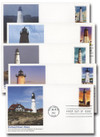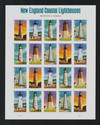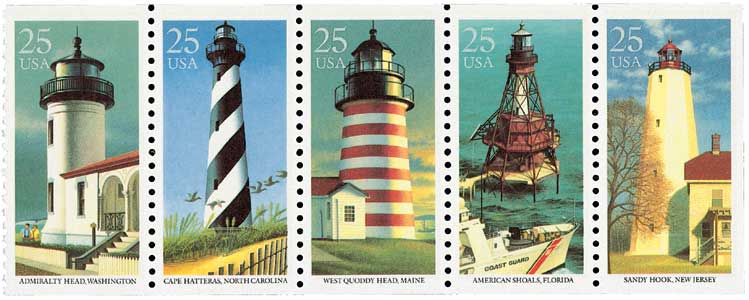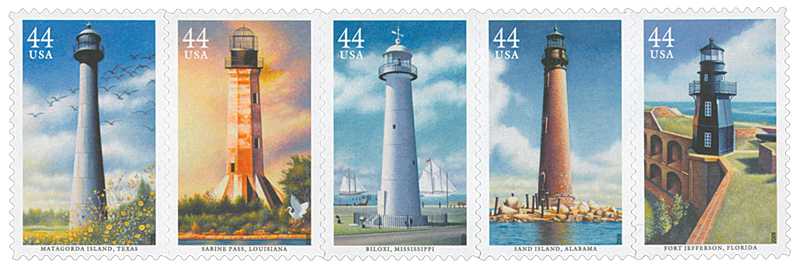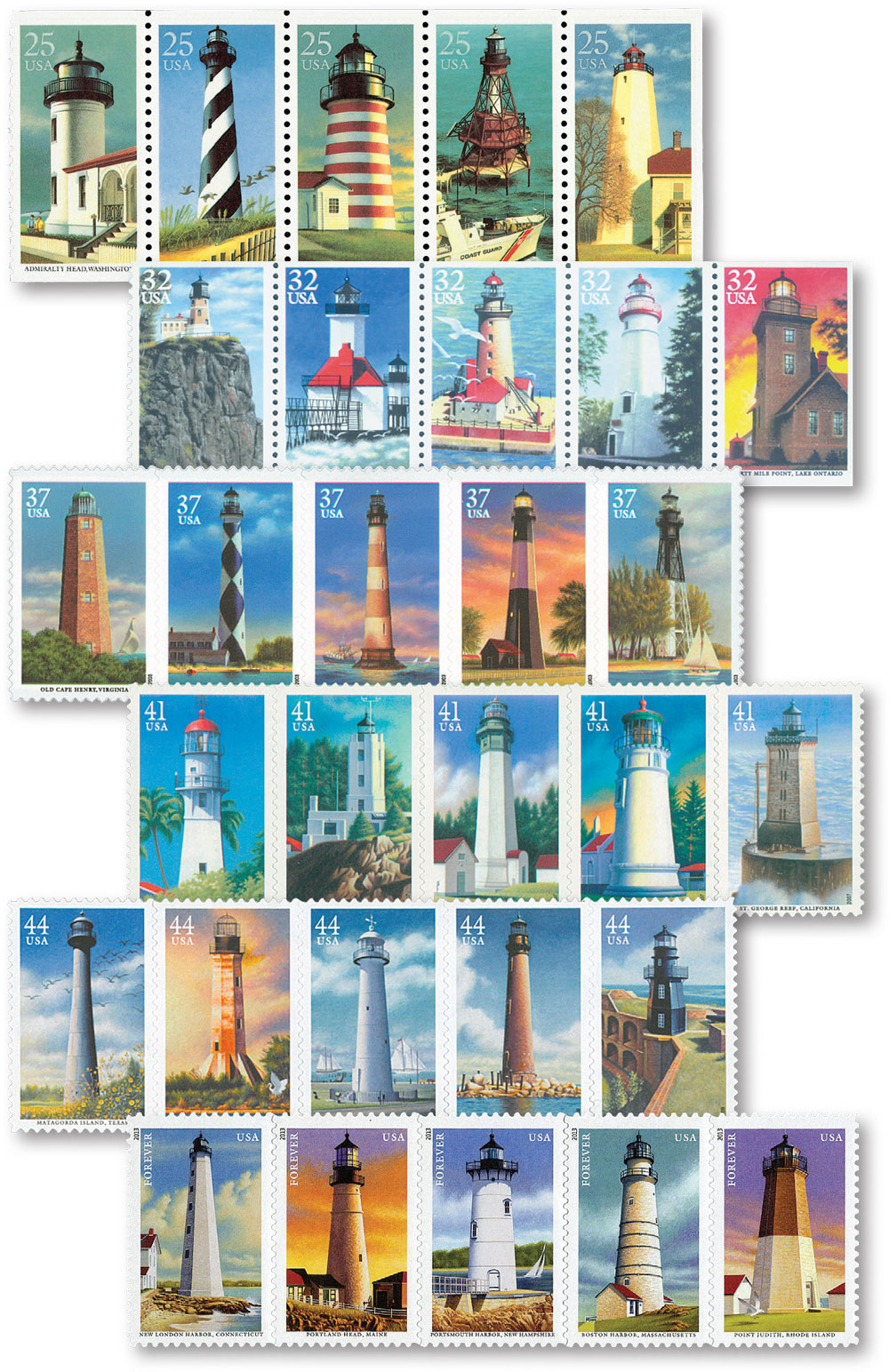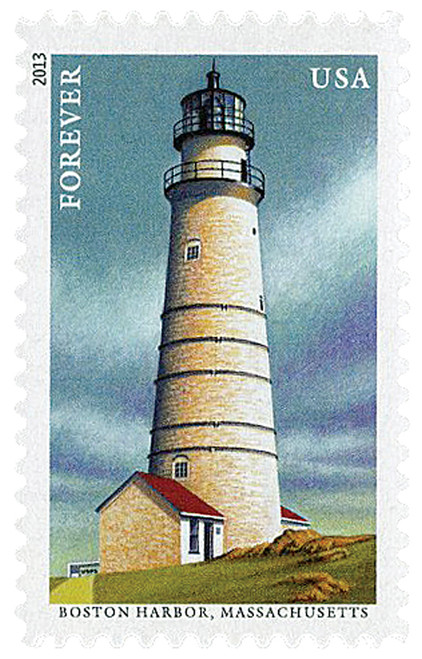
# 4791-95 - 2013 First-Class Forever Stamp - New England Coastal Lighthouses
U.S. # 4791-95
2013 46¢ New England Coastal Lighthouses
Strip of 5
Many of New England’s lighthouses guarded the Eastern shorelines before the U.S. became a country. Since then, they have become beloved landmarks to seafarers and “landlubbers” alike.
In Colonial times, the British established beacons at the busy ports of Boston and New London. During the American Revolution, the lighthouses were destroyed then rebuilt by opposing forces. When the nation gained independence, President George Washington understood the significance of the New England lighthouses and commissioned the first keepers, contracts for oil, and completion of a new station in Portland Head, Maine.
The role of lighthouses in history continued during the War of 1812. In Boston Harbor, the keeper and his wife witnessed the battle when American Captain James Lawrence declared, “Don’t give up the ship!” The lamps from Rhode Island’s Point Judith station were stolen by the British, and later found in Bermuda, returned, and reinstalled.
In the 20th century, the lanterns were extinguished along New England’s rocky coast to prevent the nation’s enemies from navigating the waterways and busy harbors.
The five lighthouses honored in 2013 are:
Portland Head, Cape Elizabeth, Maine
Portsmouth Harbor, New Castle, New Hampshire
Point Judith, Narragansett, Rhode Island
New London Harbor, New London, Connecticut
Boston Harbor, Boston, Massachusetts
Howard E. Paine and Greg Breeding used Howard Koslow’s original paintings for the 2013 lighthouse stamps. Koslow’s paintings have been used on all of the stamps in the lighthouse series since 1990.
Lighthouse Series
Beginning in 1986, the USPS began issuing topical booklets of five stamps each. Past topics had included fish, locomotives, classic cars, and steamboats. In April 1990, the set of lighthouse stamps would be the first of two such topical booklets issued that year.
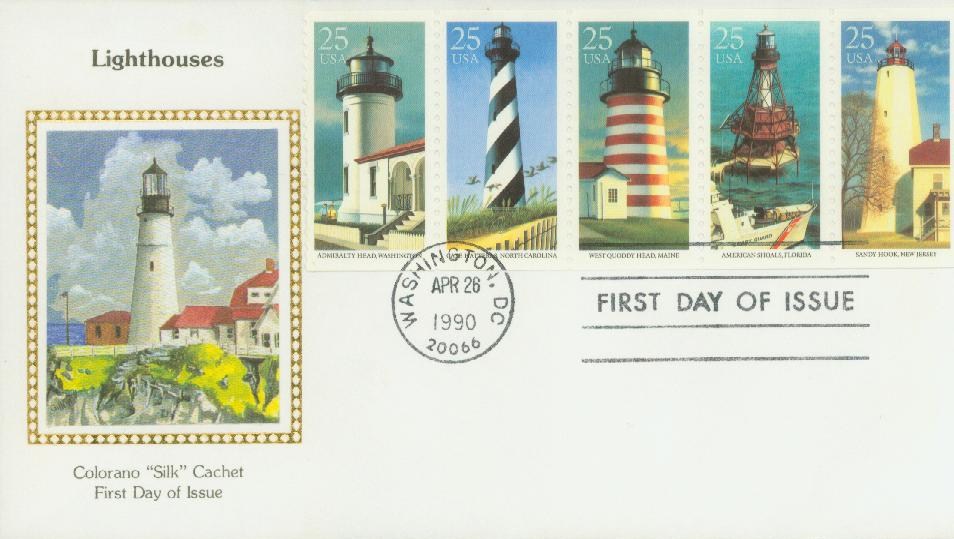
Lighthouses had been featured on stamps in the past, but some lighthouse enthusiasts were calling for more. In 1987, James W. Hyland III, chairman of the Lighthouse Preservation Society, submitted a list of 10 lighthouses he thought should be honored on stamps to the Citizens’ Stamp Advisory Committee. Initially, the committee supported his idea and proposed issuing 10 stamps in two panes honoring all of the lighthouses. However, the USPS felt that would make for too many stamps, so they opted to just issue five, though a sixth would be pictured on the booklet cover. Two of the six lighthouses had been on stamps before, Cape Hatteras and Sandy Hook.

The stamp designs were first unveiled on August 4, 1989, at the Customs House Maritime Museum in Newburyport, Massachusetts. August 4th was the anniversary of the creation of the Revenue Marine (later the Revenue Cutter Service). The stamps would be issued in 1990 to mark the 200th anniversary.
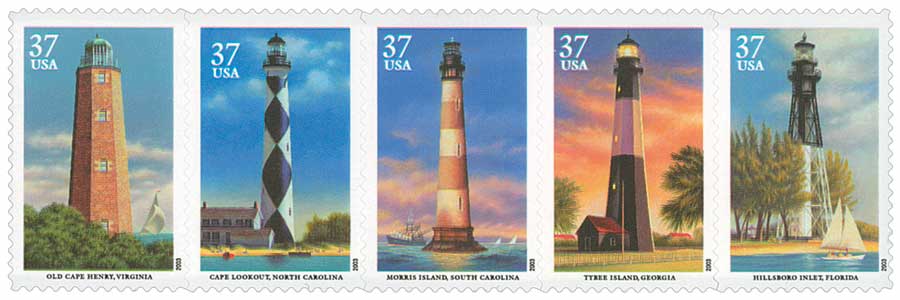
The stamps were issued on April 26, 1990, in Washington, D.C. Less than two weeks after they were issued, some booklets were discovered without the white intaglio ink for “USA” and the denomination. Some of these error books sold for over $500 each.

Five years later, the USPS issued a second booklet featuring lighthouses. They included two lighthouses from the list submitted in 1990, but all of the lighthouses in this set were ones found along the Great Lakes. Both of these sets proved quite popular, so the USPS continued issuing stamps honoring lighthouses from different areas of the country every few years, with the final issue coming in 2013.
U.S. # 4791-95
2013 46¢ New England Coastal Lighthouses
Strip of 5
Many of New England’s lighthouses guarded the Eastern shorelines before the U.S. became a country. Since then, they have become beloved landmarks to seafarers and “landlubbers” alike.
In Colonial times, the British established beacons at the busy ports of Boston and New London. During the American Revolution, the lighthouses were destroyed then rebuilt by opposing forces. When the nation gained independence, President George Washington understood the significance of the New England lighthouses and commissioned the first keepers, contracts for oil, and completion of a new station in Portland Head, Maine.
The role of lighthouses in history continued during the War of 1812. In Boston Harbor, the keeper and his wife witnessed the battle when American Captain James Lawrence declared, “Don’t give up the ship!” The lamps from Rhode Island’s Point Judith station were stolen by the British, and later found in Bermuda, returned, and reinstalled.
In the 20th century, the lanterns were extinguished along New England’s rocky coast to prevent the nation’s enemies from navigating the waterways and busy harbors.
The five lighthouses honored in 2013 are:
Portland Head, Cape Elizabeth, Maine
Portsmouth Harbor, New Castle, New Hampshire
Point Judith, Narragansett, Rhode Island
New London Harbor, New London, Connecticut
Boston Harbor, Boston, Massachusetts
Howard E. Paine and Greg Breeding used Howard Koslow’s original paintings for the 2013 lighthouse stamps. Koslow’s paintings have been used on all of the stamps in the lighthouse series since 1990.
Lighthouse Series
Beginning in 1986, the USPS began issuing topical booklets of five stamps each. Past topics had included fish, locomotives, classic cars, and steamboats. In April 1990, the set of lighthouse stamps would be the first of two such topical booklets issued that year.

Lighthouses had been featured on stamps in the past, but some lighthouse enthusiasts were calling for more. In 1987, James W. Hyland III, chairman of the Lighthouse Preservation Society, submitted a list of 10 lighthouses he thought should be honored on stamps to the Citizens’ Stamp Advisory Committee. Initially, the committee supported his idea and proposed issuing 10 stamps in two panes honoring all of the lighthouses. However, the USPS felt that would make for too many stamps, so they opted to just issue five, though a sixth would be pictured on the booklet cover. Two of the six lighthouses had been on stamps before, Cape Hatteras and Sandy Hook.

The stamp designs were first unveiled on August 4, 1989, at the Customs House Maritime Museum in Newburyport, Massachusetts. August 4th was the anniversary of the creation of the Revenue Marine (later the Revenue Cutter Service). The stamps would be issued in 1990 to mark the 200th anniversary.

The stamps were issued on April 26, 1990, in Washington, D.C. Less than two weeks after they were issued, some booklets were discovered without the white intaglio ink for “USA” and the denomination. Some of these error books sold for over $500 each.

Five years later, the USPS issued a second booklet featuring lighthouses. They included two lighthouses from the list submitted in 1990, but all of the lighthouses in this set were ones found along the Great Lakes. Both of these sets proved quite popular, so the USPS continued issuing stamps honoring lighthouses from different areas of the country every few years, with the final issue coming in 2013.



